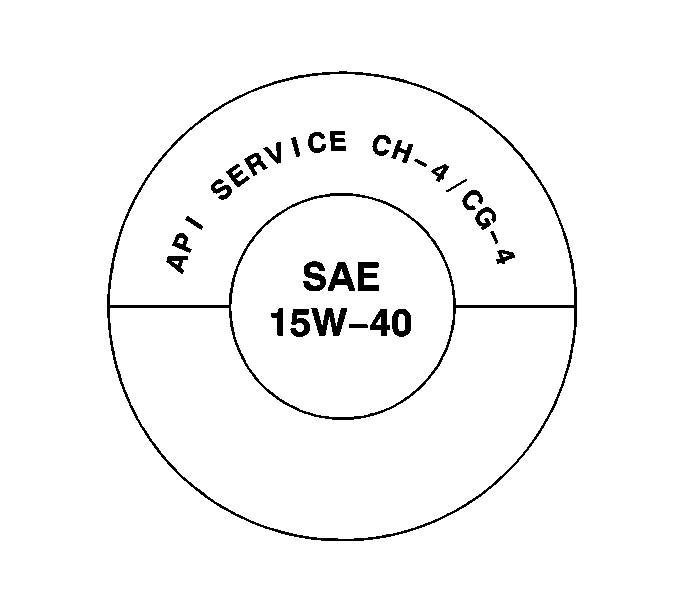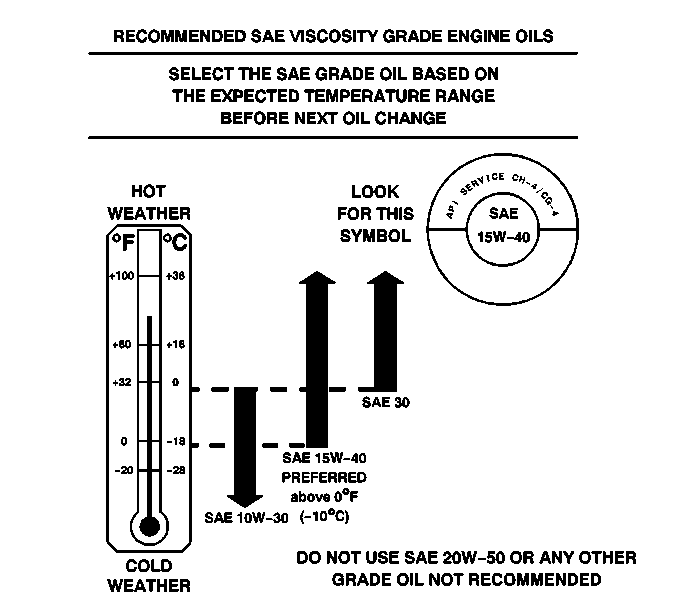For time and/or mileage intervals of scheduled maintenance items, refer to Maintenance Schedule , .
The following text and illustrations describe the details of the required scheduled maintenance services.
For information on the proper fluids and lubricants to use, refer to Fluid and Lubricant Recommendations .
Engine Oil and Filter Change
For the 7.8 L engine oil and filter changing procedure, refer to in Engine Mechanical.
Diesel Engine Oil Quality

Oils designated as API CH-4 or CG-4 are best. The CH-4 or CG-4 designations may appear either alone, together or in combination with other API designations, such as API CH-4/SJ, CG-4/SH or CH-4/CG-4/SJ.
These letters show American Petroleum Institute (API) levels of quality.
Diesel Engine Oil Viscosity

Important: As shown in the viscosity chart, SAE 15W-40 is best for your vehicle. However, you can use SAE 10W-30 if it is going to be colder than 0°C (32°F) before your next oil change. When it is very cold, below -18°C (0°F) , you should use SAE 10W-30 to improve cold starting. SAE 30 may be used at temperatures above freezing, 0°C (32°F).
These numbers on the oil container show its viscosity, or thickness. Do not use other viscosity oils such as SAE 10W-40 or SAE 20W-50.Chassis Lubrication
Refer to the illustration for the location of the lubrication points for the chassis. Lubricate the transmission shift linkage. Lubricate the park brake guides, the underbody contact points and the linkage.
Lubricating Joints that have Grease Fittings
Refer to the illustration for the location of the grease fittings
Important: Wipe off all dirt from the grease fitting before lubricating the joint. Ball joints should not be lubricated unless the temperature of the ball joints is -12°C (10°F) or higher. During cold weather, allow the ball joint to warm up as necessary before being lubricated. Use a low-pressure grease gun on all joints in order to prevent seal damage.
Apply grease slowly while watching the grease seal. Apply the grease until the grease is seen bleeding from the seal. If the seal expands but you do not see any grease, do not apply any more grease. Allow time for the grease to bleed from the seal.
Lubricate the steering linkage, the upper and the lower ball joint.
Tire and Wheel Inspection and Rotation
Inspect the tires for abnormal wear or damage. Rotate the tires in order to equalize the wear and obtain maximum tire life. Refer to in Tires and Wheels. If irregular or premature wear exists, refer to in Tires and Wheels.
Accessory Drive Belt Inspection
Inspect the accessory drive belts for the following:
| • | Cracks |
| • | Fraying |
| • | Wear |
| • | Proper tension |
Refer to for the 6.6 L Engine.
Automatic Transmission
Change both the fluid and the filter according to the maintenance schedule intervals. For maintenance schedule information, refer to .
For the fluid and filter changing procedure, refer to 4L60-E in Automatic Transmission or 4L80-E in Automatic Transmission.
Refer to Allison Transmission.
Fuel Filter Replacement
Replace the fuel filter according to the maintenance schedule intervals with the correct type. For maintenance schedule information, refer to .
For information on the correct type of fuel filter, refer to .
Passenger Compartment Air Filter Replacement
Replace the passenger compartment air filter. Refer to in Heating, Ventilation, and Air Conditioning.
Drive Axle Service
Change the axle fluid according to the maintenance schedule intervals. For the maintenance schedule refer to .
For axle capacities, refer to
For the procedure to check the fluid level refer to
Shields and Underhood Insulation Inspection
Inspect the shields and underhood insulation condition. Replace the shields and underhood insulation if damaged.
Cooling System Service
Drain, flush and refill the cooling system with new coolant. Refer to in Engine Cooling.
For time and or mileage intervals of scheduled maintenance items, refer to .
